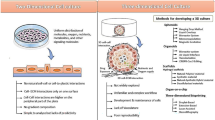Abstract
The aim of our study is to explore the possibility of using an ancient method of culture technique- the hanging drop technique for stem cell differentiation and cytotoxicity testing. We demonstrate here a variety of novel applications of this age old technique not only to harness the differentiation potential of stem cells into specific lineages but also for cytotoxicity studies. Here we have prepared hanging drop cultures by placing 20 µl micro-drops of nutrient media and 10% Fetal Calf Serum (FCS) containing cells of interest on the lids of 60 mm dishes. Bottom plates of the dishes were filled with sterile Phosphate Buffer Saline (PBS) to avoid desiccation of samples. Lids were then placed on the bottom plates to achieve hanging drop cultures. We utilized this technique for cultivation of ciliated epithelia to study cytotoxicity and differentiation of bone marrow stromal cells. Most importantly the modified culture technique presented here is simple, economical and cost effective in terms of the time taken and the reagents required and are amenable to goal specific modification such as cytotoxicity testing. It is advantageous over the existing system in terms of retention of viability and functionality for longer duration and for providing three dimensional growth micro-environment making it useful for organotypic cultures and in vivo simulation.
Similar content being viewed by others
References
Carrel A (1992) The permanent life of tissues outside the organism. J Exp Med 15:516–528
Harrison RG (1907) Observations on the living developing nerve fibres. Proc Soc Exp Bio Med 4:140–143
Kelm JM, Ehler E, Nielsen LK, Schlatter S, Perriard JC and Fussenegger M (2004) Design of artificial myocardial micro tissues. Tissue Eng 10:201–214
Kawakami N, Sakane N, Nishizawa F, Iwao M, Fukada SI, Tsujikawa K, Kohama Y, Ikawa M, et al (1999) Green fluorescent protein-transgenic mice: immune functions and their application to studies of lymphocyte development. Immunol Lett 70:165–71
Ali NN, Xu X, Brito-Martins M, Poole-Wilson PA, Harding SE, Fuller SJ (2004) Beta-adrenoceptor subtype dependence of chronotropy in mouse embryonic stem cell-derived cardiomyocytes. Basic Res Cardiol 99:382–391
Medvinskii LA, Kolesnichenko TS (1981) Modification of the “hanging drop” method and its application to cultivation of re-aggregates of dissociated cells and explants of embryonic lungs. Biull Eksp Biol Med 91:379–381
Banerjee M, Kumar A, Bhonde RR (2005) Reversal of experimental diabetes by multiple bone marrow transplantation. BBRC 328:318–325
Bhonde RR, Wagh UV, Gupta NP (1983) Replication of non-respiratory viruses in tracheal organcultures. Br J Exp Pathol 64:1–5
Gron B, Andersson A, Dabelsteen E (1999) Blood-group-related carbohydrates are expressed in organotypic cultures of human skin and oral mucosa. APMIS 107:779–790
Sikavitsas VI, Bancroft GN, Holtorf HL, Jansen JA, Mikos AG (2003) Mineralized matrix deposition by marrow stromal osteoblasts in 3D perfusion culture increases with increasing fluid shear forces. Proc Nat Acad Sci USA 100:14683–14688
Wang L, Shelton RM, Cooper PR, Lawson M, Triffitt JT, Barralet JE (2003) Evaluation of sodium alginate for bone marrow cell tissue engineering. Biomaterials 24:3475–3481
Tun T, Miyoshi H, Aung T, Takahashi S, Shimizu R, Kuroha T, Yamamoto M, Ohshima N (2002) Effect of growth factors on ex vivo bone marrow cell expansion using three-dimensional matrix support. Artif Organs 26:333–339
Li AD, Liu XL, Duan BC, Ma J (2005) Thymic Nurse Cells Support CD4(−)CD8(+) Thymocytes to Differentiate into CD4(+)CD8(+) Cells. Cell Mol Immunol 4:301–305
Gutierrez L, Lindeboom F, Ferreira R, Drissen R, Grosveld F, Whyatt D, Philipsen S (2005) A hanging drop culture method to study terminal erythroid differentiation. Exp Hematol 33:1083–1091
Duca D, Werbowetski T, Maestro RF (2004) Spheroid preparation from hanging drops: characterization of a model of brain tumor invasion. J Neurooncol 67:295–303
Kelm JM, Timmins NE, Brown CJ, Fussenegger M, Nielsen LK (2003) Method for generation of homogeneous multicellular tumor spheroids applicable to a wide variety of cell types. Biotechnol Bioeng 83:173–180
Acknowledgements
Authors wish to acknowledge the Director, National Centre for Cell Science for support and encouragement to carry out the present work.
Author information
Authors and Affiliations
Corresponding author
Rights and permissions
About this article
Cite this article
Banerjee, M., Bhonde, R.R. Application of hanging drop technique for stem cell differentiation and cytotoxicity studies. Cytotechnology 51, 1–5 (2006). https://doi.org/10.1007/s10616-006-9001-z
Received:
Accepted:
Published:
Issue Date:
DOI: https://doi.org/10.1007/s10616-006-9001-z




